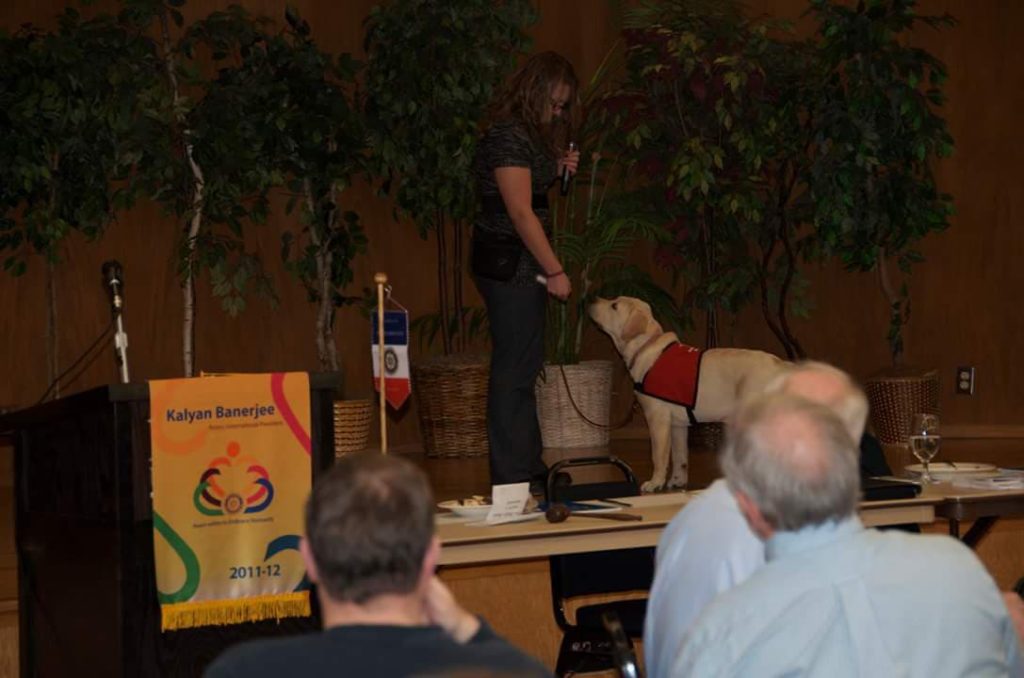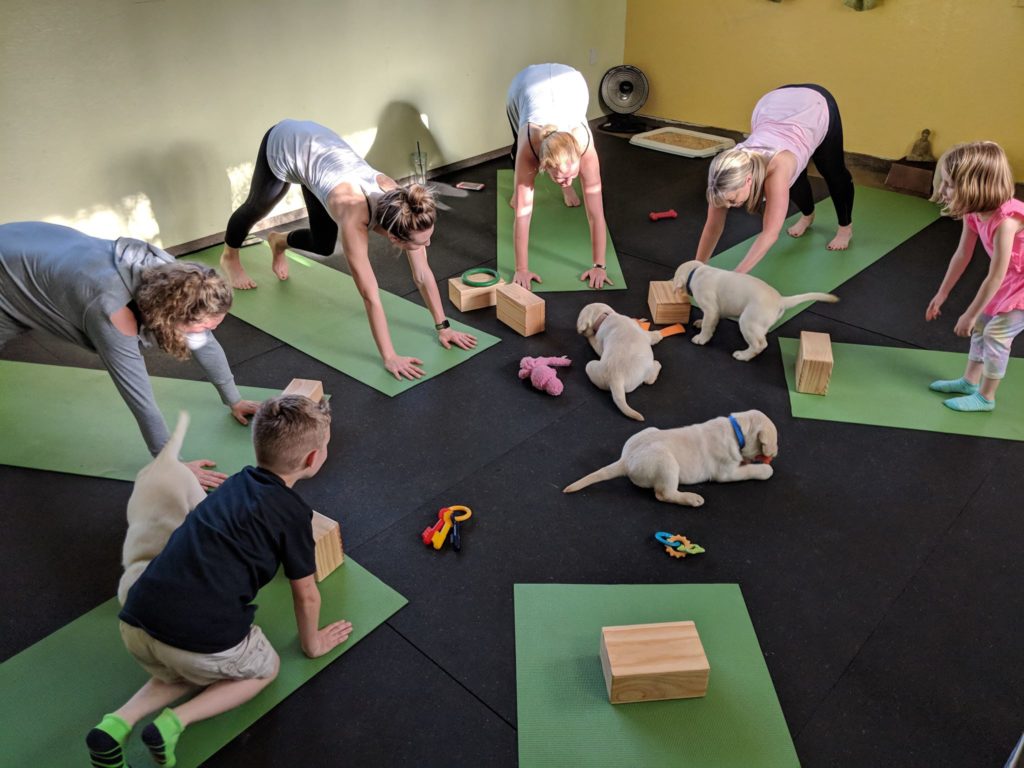
Most of you have heard of guide dogs and emotional support animals. Maybe you have even heard of diabetic alert dogs. Today we showcase Kristin, one of the pioneers in this field, and show just how important this life-saving work is.

It’s just after lunch. 12-year-old Bryce looks like any other sixth grader as he sits at his desk, copying down the latest assignment the teacher has given into his spiral notebook. His companion, Scout, a golden lab, lays at his feet. Scout, a diabetic alert dog, is trained to smell when Bryce’s blood sugar drops down into dangerous territory. A few minutes pass. Scout sits up, head alert, nose in the air. He hits Bryce’s lap with his paw, three times. Bryce ignores it.
Once more, Scout paws him. One, two, three. Again, Bryce ignores him and continues with his studies. After Scout’s third attempt to get Bryce’s attention, he ups the ante and does something he was never trained to do. He jumps into a shocked Bryce’s lap, and knocks him off his chair. Bryce is paying full attention now. He checks his blood sugar level and finds it still within the normal range.
“See boy, it’s ok.” He says to the dog as he pats his head. Scout paws again. “Alright, I’ll drink some juice, will that make you happy?” He grabs some orange juice and chugs it down.
Minutes later, Bryce passes out. His body shakes. Paramedics are called. His consciousness returns as he is loaded into the ambulance. “Where is my dog?” He asks. “He saved my life today.”
Earlier at lunch, Bryce had inadvertently double dosed his insulin level, and his blood sugar had dropped too low, too fast for the meter to even register it. Scout’s nose had picked it up first. If Bryce had not trusted the dog and drank the juice when he did, he could very well have died that day.
“That,” says trainer, 35-year-old Kristin Tarnowski, “Is the day I realized how important these dogs really are.” Her interest in diabetic alert dogs began in 2008, at the Montessori school where she taught. A little girl attended the school who had type one diabetes, and Kristin oversaw checking her blood sugar and figuring out the insulin doses. She learned about diabetic alert dogs through Guide Dogs for the Blind, a program she had been working with since her senior year in high school, breeding and training dogs for them.
Kristin, together with the girl’s parents decided, “We need to find her a dog.”
Back then, the concept of diabetic alert dogs was new, and very expensive. And, it was not a solution readily available to young children with diabetes. After extensive research, Kristin found one reputable place on the East Coast who offered these dogs. The price? $60,000 for a trained dog.
Kristin is no stranger to problem solving. She recalls the spring of 1996. At thirteen years old, she wanted to buy a cow to care for on her family’s farm. She asked her parents if they could buy one. Their response; “Come up with a business plan on the economics of purchasing a cow, and we will see.”
She spent a few weeks researching and crafting a plan. She then handed her mother and father the carefully detailed paper, including:
• How much it would cost to buy the cow and feed it.
• How much she could make by selling the calves the cow produced.
• How much money the family would save on dairy products.
After her presentation, she was met with a “Yes”.
“I wouldn’t be where I am in my life today, if it hadn’t been for my parents.” Kristin says. “My Mom always said, ‘the worst they can say is no’. From that, the mentality I’ve had in life is, just ask. Why not?”
When Kristin saw the $60,000 price tag for the diabetic alert dog, she was blown away. But instead of giving in, or giving up, she looked outside the box for a different possibility. “Instead of just buying one dog with that money, let’s figure out how to train dogs, and offer them to people at a more reasonable price.”
She took one of her guide dog flunk-outs, Dewitt, and trained him as her very first diabetic alert dog graduate. Once she saw that it worked, she started the non-profit, Dogs Assisting Diabetes Foundation.
The price of the dog varies, depending on who will be doing the training. “It takes at least a year to train an alert dog, and usually longer when other people are training the dogs.” She says. It is more economical for most people to buy the service dog and be coached through the training. In this case, including the purchase of the dog, and the required training hours, the pup would cost between $6,000 to $8,000, over the course of a year. If Kristin boards and trains them herself, the price tag is about $20,000 for the year. Even then, her cost is still $40,000 less than the original dogs she had found.
Training is a process which begins early. First, there is the socialization, the behavior training. Kristin has people come in to socialize with the pups at a very young age. Children, men, women, bikers with ‘scary’ helmets. Then, once old enough, she (or one of her helpers), takes them out into the wider world. To baseball stadiums, coffee shops and house parties.
Second, there is the scent work. When a diabetic client has a confirmed high or low blood sugar level, she has them send her sweat samples. Using a cosmetic cotton swab, they wipe behind their knees, or anywhere sweat accumulates. Then, they put the sample into a sterile container. Once Kristin has them, she marks them and stores them in the freezer.
When she is ready to work with the pups, she hides the samples around the house, behind sofas, and inside containers. Her training uses all positive reinforcement, with food and clickers as rewards.
“Every time they find that scent, they know they are going to be paid really well for it. The dogs turn it into a hunting game.”
Finally, she teaches the alert behavior separately. The pups learn how to paw three consecutive times. She also teaches them to bite a little toy that hangs from their leash, which rings a wireless doorbell. Over time, she chains each piece of the process together, to make a fluid behavior. By the end of their training, the dogs can consistently deliver the alerts when they smell the scent.

With a degree from Oregon State University in animal science and a master’s in education, Kristin is well prepared for the training she does daily. Not only does she breed and train labs and French bull dogs for her foundation, she also breeds pups for individuals looking for a pet. She provides group puppy training classes, “which is really a process of training the owners, more than the dogs”, she says. And then there is her latest venture, PuppYoga.
Yoga mats line the floor, while eight men, women and children take deep, cleansing breaths. As opposed to the usual calming energy the stretching elicits, there is a tangible zing in the air. The participants await the guests of honor, eight rambunctious nine-week-old Frenchies, yipping just out of sight.
The door barely opens, when the room explodes in giggles as the pups add a whole new element to the downward dog pose. Throughout the session, they chew hair and climb into laps. Belly laughs are the theme of the evening.
“We haven’t laughed like that since I don’t know when.” One mother tells Kristin, her arm draped around her teenage daughter. Kristin smiles, reminded again of the important role these dogs play; in the joy they provide, the comfort they give, and the lives they save.




